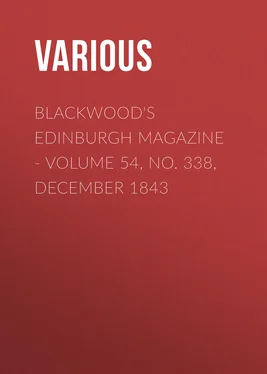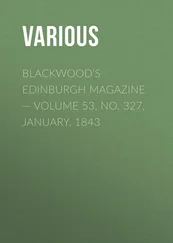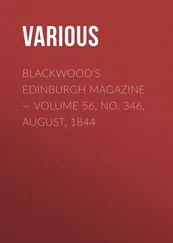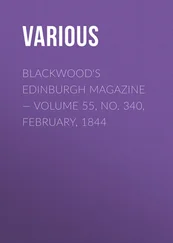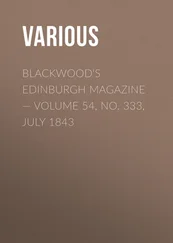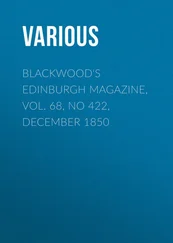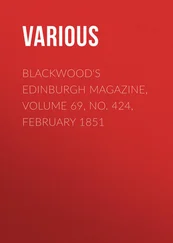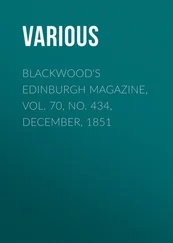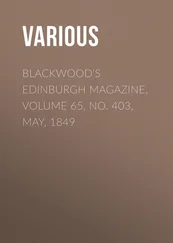Various - Blackwood's Edinburgh Magazine - Volume 54, No. 338, December 1843
Здесь есть возможность читать онлайн «Various - Blackwood's Edinburgh Magazine - Volume 54, No. 338, December 1843» — ознакомительный отрывок электронной книги совершенно бесплатно, а после прочтения отрывка купить полную версию. В некоторых случаях можно слушать аудио, скачать через торрент в формате fb2 и присутствует краткое содержание. Издательство: Иностранный паблик, Жанр: foreign_antique, periodic, foreign_edu, на английском языке. Описание произведения, (предисловие) а так же отзывы посетителей доступны на портале библиотеки ЛибКат.
- Название:Blackwood's Edinburgh Magazine - Volume 54, No. 338, December 1843
- Автор:
- Издательство:Иностранный паблик
- Жанр:
- Год:неизвестен
- ISBN:нет данных
- Рейтинг книги:3 / 5. Голосов: 1
-
Избранное:Добавить в избранное
- Отзывы:
-
Ваша оценка:
- 60
- 1
- 2
- 3
- 4
- 5
Blackwood's Edinburgh Magazine - Volume 54, No. 338, December 1843: краткое содержание, описание и аннотация
Предлагаем к чтению аннотацию, описание, краткое содержание или предисловие (зависит от того, что написал сам автор книги «Blackwood's Edinburgh Magazine - Volume 54, No. 338, December 1843»). Если вы не нашли необходимую информацию о книге — напишите в комментариях, мы постараемся отыскать её.
Blackwood's Edinburgh Magazine - Volume 54, No. 338, December 1843 — читать онлайн ознакомительный отрывок
Ниже представлен текст книги, разбитый по страницам. Система сохранения места последней прочитанной страницы, позволяет с удобством читать онлайн бесплатно книгу «Blackwood's Edinburgh Magazine - Volume 54, No. 338, December 1843», без необходимости каждый раз заново искать на чём Вы остановились. Поставьте закладку, и сможете в любой момент перейти на страницу, на которой закончили чтение.
Интервал:
Закладка:
In the commencement of the lecture, there are offered some definitions of the terms of art, "nature, grace, taste, copy, imitation, genius, talent." In that of nature, he seems entirely to agree with Reynolds; that of beauty leaves us pretty much in the dark in our search for it, "as that harmonious whole of the human frame, that unison of parts to one end, which enchants us. The result of the standard set by the great masters of our art, the ancients, and confirmed by the submissive verdict of modern imitation." This is unphilosophical, unsatisfactory; nor is that of grace less so—"that artless balance of motion and repose, sprung from character, founded on propriety, which neither falls short of the demands, nor overleaps the modesty of nature. Applied to execution it means that dexterous power which hides the means by which it was attained, the difficulties it has conquered." We humbly suggest, that both parts of this definition may be found where there is little grace. It is evident that the lecturer did not subscribe to any theory of lines, as per se beautiful or graceful, and altogether disregarded Hogarth's line of beauty. Had Mr Hay's very admirable short works—his "Theory of Form and Proportion"—appeared in Mr Fuseli's day, he would have taken a new view of beauty and grace. By taste, he means not only a knowledge of what is right in art, but a power to estimate degrees of excellence, "and by comparison proceeds from justness to refinement." This, too, we think inadequate to express what we mean by taste, which appears to us to have something of a sense, independent of knowledge. Using words in a technical sense, we may define them to mean what we please, but certainly the words themselves, "copy" and "imitation," do not mean very different things. He thinks "precision of eye, and obedience of hand, are the requisites for copy, without the least pretence to choice, what to select, what to reject; whilst choice, directed by judgment or taste, constitutes the essence of imitation, and alone can raise the most dexterous copyist to the noble rank of an artist." We do not exactly see how this judgment arises out of his definition of "taste." But it may be fair to follow him still closer on this point. "The imitation of the ancients was, essential , characteristic , ideal . The first cleared nature of accident, defect, excrescence, (which was in fact his definition of nature, as so cleared;) the second found the stamen which connects character with the central form; the third raised the whole and the parts to the highest degree of unison." This is rather loose writing, and not very close reasoning. After all, it may be safer to take words in their common acceptation; for it is very difficult in a treatise of any length, to preserve in the mind or memory the precise ideas of given definitions. "Of genius, I shall speak with reserve; for no word has been more indiscriminately confounded. By genius, I mean that power which enlarges the circle of human knowledge, which discovers new materials of nature, or combines the known with novelty; whilst talent arranges, cultivates, polishes the discoveries of genius." Definitions, divisions, and subdivisions, though intended to make clear, too often entangle the ground unnecessarily, and keep the mind upon the stretch to remember, when it should only feel. We think this a fault with Mr Fuseli; it often renders him obscure, and involves his style of aphorisms in the mystery of a riddle.
Second Lecture.—This lecture comprises a compendious history of modern art; commencing with Massaccio. If religion gave the impulse to both ancient and modern, so has it stamped each with the different characters itself assumed. The conceptions the ancients had of divinity, were the perfection of the human form; thus form and beauty became godlike. The Christian religion wore a more spiritual character. In ancient art, human form and beauty were triumphant; in modern art, the greater triumph was in humility, in suffering; the religious inspiration was to be shown in its influence in actions less calculated to display the powers, the energies of form, than those of mind. Mere external beauty had its accompanying vices; and it was compelled to lower its pretensions considerably, submit to correction, and take a more subordinate part. Thus, if art lost in form it gained in expression, and thus was really more divine. Art in its revival, passing through the barbarity of Gothic adventurers, not unencumbered with senseless superstitions, yet with wondrous rapidity, raised itself to the noblest conceptions of both purity and magnificence. Sculpture had, indeed, preceded painting in the works of Ghiberti Donato and Philippo Brunelleschi, when Massaccio appeared. "He first perceived that parts are to constitute a whole; that composition ought to have a centre; expression, truth; and execution, unity. His line deserves attention, though his subjects led him not to investigation of form, and the shortness of his life forbade his extending those elements, which Raffaelle, nearly a century afterwards, carried to perfection." That great master of expression did not disdain to borrow from him—as is seen in the figure of "St Paul preaching at Athens," and that of "Adam expelled from Paradise." Andrea Mantegna attempted to improve upon Massaccio, by adding form from study of the antique. Mr Fuseli considers his "taste too crude, his fancy too grotesque, and his comprehension too weak, to advert from the parts that remained to the whole that inspired them; hence, in his figures of dignity or beauty, we see not only the meagre forms of common models, but even their defects tacked to ideal torsos." We think, however, he is deserving of more praise than the lecturer was disposed to bestow upon him, and that his "triumphs," the processions, (at Hampton Court,) are not quite justly called "a copious inventory of classic lumber, swept together with more industry than taste, but full of valuable materials." Yet when it is said, that he was "not ignorant of expression," and that "his Burial of Christ furnished Raffaelle with composition, and even "some figures and attitudes," the severity of the opinion seems somewhat mitigated. Luca Signorelli, more indebted to nature than the study of the antique, "seems to have been the first who contemplated with a discriminating eye his object; saw what was accidental, and what essential; balanced light and shade, and decided the motion of his figures. He foreshortened with equal boldness and intelligence." It was thought by Vasari, that in his "Judgment," Michael Angelo had imitated him. At this period of the "dawn of modern art, Leonardo da Vinci broke forth with a splendour which distanced former excellence; made up of all the elements that constitute the essence of genius; favoured by education and circumstances—all ear, all eye, all grasp; painter, poet, sculptor, anatomist, architect, engineer, chemist, machinist, musician, man of science, and sometimes empiric, he laid hold of every beauty in the enchanted circle, but without exclusive attachment to one, dismissed in her turn each." "We owe him chiaroscuro, with all its magic—we owe him caricature, with all its incongruities." His genius was shown in the design of the cartoon intended for the council-chamber at Florence, which he capriciously abandoned, wherein the group of horsemen might fairly rival the greatness of Michael Angelo himself; and in the well-known "Last Supper," in the refectory of the Dominicans at Milan, best known, however, from the copies which remain of it, and the studies which remain. Fra Bartolomeo, "the last master of this period, first gave gradation to colour, form and masses to drapery, and a grave dignity, till then unknown, to execution." His was the merit of having weaned Raffaelle "from the meanness of Pietro Perugino, and prepared for the mighty style of Michael Angelo Buonarotti." Mr Fuseli is inspired by his admiration of that wonderful man, as painter, sculptor, and architect.
Читать дальшеИнтервал:
Закладка:
Похожие книги на «Blackwood's Edinburgh Magazine - Volume 54, No. 338, December 1843»
Представляем Вашему вниманию похожие книги на «Blackwood's Edinburgh Magazine - Volume 54, No. 338, December 1843» списком для выбора. Мы отобрали схожую по названию и смыслу литературу в надежде предоставить читателям больше вариантов отыскать новые, интересные, ещё непрочитанные произведения.
Обсуждение, отзывы о книге «Blackwood's Edinburgh Magazine - Volume 54, No. 338, December 1843» и просто собственные мнения читателей. Оставьте ваши комментарии, напишите, что Вы думаете о произведении, его смысле или главных героях. Укажите что конкретно понравилось, а что нет, и почему Вы так считаете.
